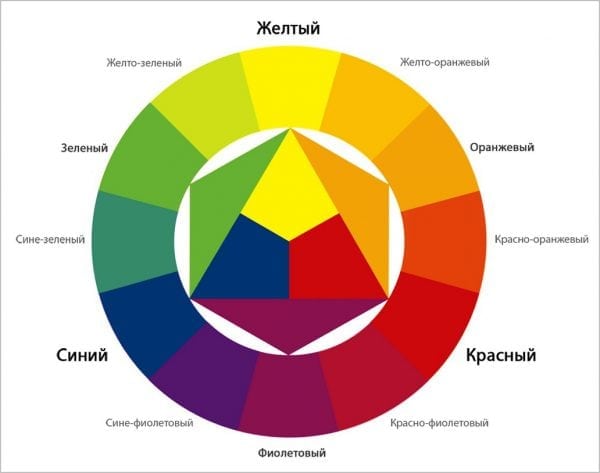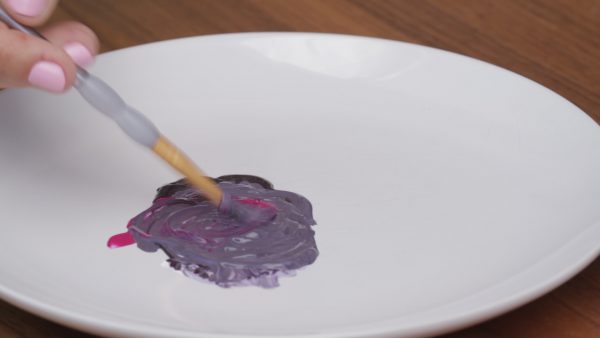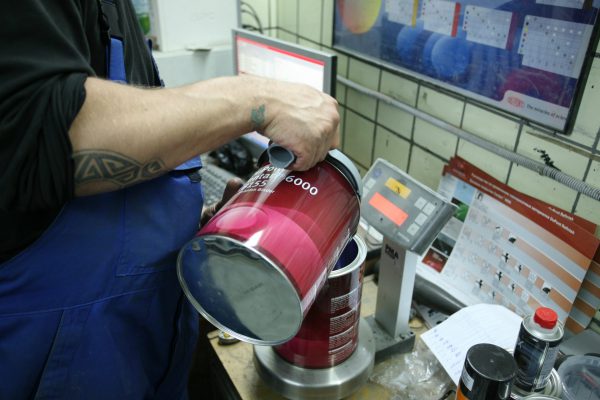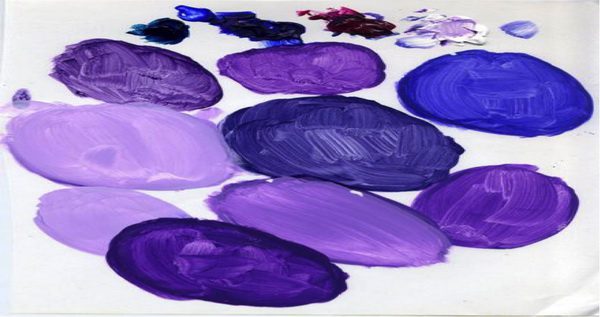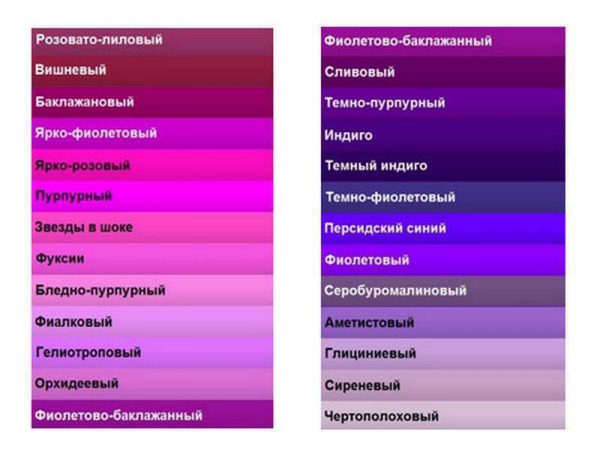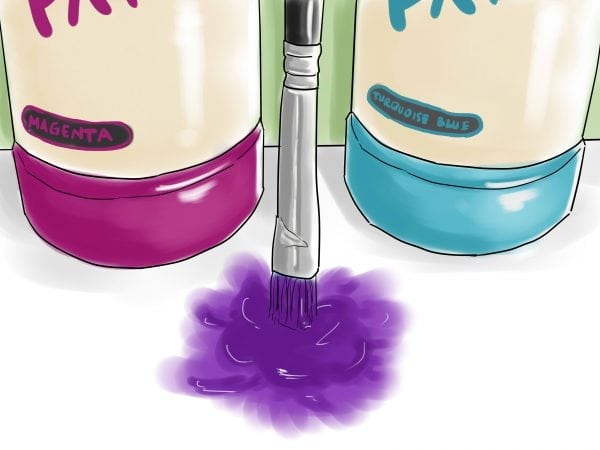Since school times, everyone knows how to get purple - you need to combine red and blue. But the result is not always obtained suitable for use - sometimes the shade is too dark or grayish. Professionals have their own secrets to creating purple when mixing paints, it is worth getting acquainted with them.
- Violet in the color picker
- Historical reference
- A simple way to get purple
- Different shades of purple
- Light violet and pale violet of gouache paints
- Dark purple color from gouache paint
- Purple colour
- Purple color
- Shades of Violet - Palette
- Color mixing table
- Features of working with watercolors, oil paints, gouache
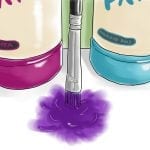
Violet in the color picker
Violet color is not basic: they include only red, yellow, blue, white and black. Simply put, it can be obtained by mixing the remaining colors, which is what artists use when painting. It is impossible to produce the basic colors of the palette by combining other shades.
According to chromotherapy, purple has a beneficial effect on the human body, especially on the senses. Visualization of this color leads to an increase in the production of endorphins - hormones of joy. Also, purple helps with insomnia, migraines, nervous disorders due to a calming effect. It is believed that it has a positive effect on the immune system, pituitary, and organs of vision. But to overload space with this shade is not worth it - it can provoke melancholy.
to contents ↑Historical reference
The violet tone always symbolized mystery, mysticism. Its history has royal "roots" - in Byzantium the color was considered imperial, in England only the reigning persons, members of their families were entitled to wear purple clothes. Catholic bishops still use purple robes, and in the Middle Ages the shade was the main one in decorating the cathedrals.
A simple way to get purple
Coloring has the simplest method to produce a purple tone. To do this, take in equal proportions red and blue watercolor or acrylic paint, gouache, mix them together. Mix the dyes carefully so that there are no stains. The depth and brightness of the resulting paint will depend on the tones of the original colors, the accuracy of calculating the proportions. Sometimes the artist at all turns purple - it is very similar to purple, but has a more pronounced red glow.
to contents ↑Different shades of purple
There are many ways to make a new paint, there are many options. With simple actions, you can get shades - from dark to light purple, lilac, violet, cold purple, etc. This is especially important for artists using a rich color palette.
Light violet and pale violet of gouache paints
It is difficult to bring the desired shade to the ideal. Usually it is obtained experimentally by swabbing on paper, adding components to the desired result. It is especially difficult for those who mix tones for tinting walls - one must be careful. You can not mix paints in large proportions and apply them directly to the canvas. A preliminary test is required.
You can get light shades of purple using a combination of pink and blue. The easiest way is to take ready-made pink gouache or watercolor, drip a couple of drops on a plastic palette, and then add blue paint. There is a more difficult option when blue and pink are not available. Then they take red and blue paints, dilute them with whitewash and get the corresponding tones. Further, when they are combined, a pale purple color comes out.
The most beautiful shades come out when using such paints:
- cobalt red;
- azure;
- ultramarine;
- phthalocyanine.
Make a muted purple color in a different way. This will require a cool red tone (e.g., Alizarin). Black paint is introduced into it in small portions. After receiving a saturated purple color, it is diluted strongly with whitewash or ordinary white gouache. This will allow you to get different shades of purple right down to pastel.
to contents ↑Dark purple color from gouache paint
Artists use a special spatula for mixing tones - a palette knife. It allows you to perfectly mix gouache without stripes, stains in a future drawing. Especially useful is a spatula for connecting bright purple flowers, dark shades.
The easiest way to create saturated colors is to mix the cool shades of blue and red. But if they have warmer reflections, there is a risk of getting a poor quality result. The finished paint may have a brown or gray tint. In this case, the introduction of a small amount of black gouache will help to correct the situation.
Mixing cold red and black will give a violet color even without blue paint. The main thing is to apply only deep black tones (black resin and others). Black should be introduced slowly, in very small portions. It strongly absorbs red and is required in a minimum amount.
To get the brightest purple tone, you can combine the colors of cyan (blue) and magenta. When diluted with whitewash, lighter shades will come out. In contrast, the finished violet can be “thickened” by the introduction of black gouache.
to contents ↑Purple colour
He is very fond of designers, artists, decorators and even culinary specialists. To get lilac color, use a white palette or an ordinary ceramic plate in white (so that there is no distortion of tone). Masters often carry out such work on a white canvas.
Lilac is considered a cold shade, so it can also be obtained by mixing cold blue and red tones. Next, color should be whitened to produce the desired shade. If the finished color shines pink, reddish, inject more blue or a drop of black. The latter perfectly absorbs unnecessary redness.
to contents ↑Purple color
The color violet, lavender, dark inflorescences of lilac is called purple. It resembles purple and lilac, but differs in a large number of red tones. Professionals have a way to get a real purple hue. To do this, the source red should have a minimum of orange reflection. Pale lilac will come out as a result of a combination of pink, white and finished purple flowers. This tone will resemble the shade of the evening sky. By introducing new portions of blue, white, pink and red tint, the following tones are obtained:
- opera mauve;
- mauve with gray;
- blue lilac.
to contents ↑In general, all lilac tones are divided into categories "K" and "C". In the former, red dominates, in the latter, blue. Lavender-gray tint is obtained by the introduction of pink and black.
Shades of Violet - Palette
There is a huge variety of violet shades that are widely used in the design of clothes, interior. In total, artists use more than 200 tones, where there are bright, delicate, grayish, cold and warm, dull and saturated colors. Their names are different - from simple to bizarre. Here are the most popular ones:
- dark ones - eggplant, mulberry, plum, blackcurrant, figs, prunes, blackberries, raisins;
- dark cold - electrician purple, indigo, dark purple;
- fuchsia group - cyclamen, thundercloud, crimson;
- purple group - beets, peony, phlox;
- light - crocus, lilac, mallow, orchid, lilac, mov, iris, hyacinth;
- the lightest - amethyst, pansies, heather, pearls.
to contents ↑To obtain a number of original shades, experts advise introducing gray, pink, brown and even orange colors - no need to be afraid of experiments.
Color mixing table
Artists know very well which colors of paints or pencils are well connected with each other, and which give ugly tones. The former are called chromatic (they are nearby in a circle of compatibility), the latter are achromatic (located far from each other). Therefore, before starting the connection of colors, it is important to familiarize yourself with the table, as well as to clarify the chemical composition of the paints - it should be similar.
Regarding Violet Tones color mixing table looks like that:
| Shade of purple | Mixed Tones | ||
|---|---|---|---|
| Bright purple | Raspberry (red) | Turquoise (Blue) | — |
| Light purple | Pink | Blue | White |
| Dark purple | Blue | Red | The black |
| Dirty purple | Purple | Dark green | — |
Features of working with watercolors, oil paints, gouache
Gouache is easier to work with than other types of paints. This type of color is rich, deeply pigmented, so adjusting the shade of purple is not difficult. It must be remembered that when dried, gouache is a little lighter, so the desired shade should be made a little darker. Watercolor has a translucent texture. In this case, it is possible to increase the “pallor” of paint without whitening, using ordinary water. But in the picture, watercolor does not look as bright as gouache.
It is more difficult to work with oil paints, they have a special structure and high fluidity. Mixing the composition should be especially careful so that all layers are combined into a single whole. Artists also apply other methods of mixing oil - the application of tones, optical technology. In the first case, strokes are applied to each other, in the second case they are mixed directly on the canvas. Beginners should start work on creating original shades precisely with gouache - the classes will be fascinating and will appeal to children and adults!

